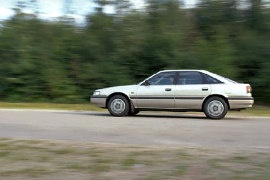
MAZDA 626 Hatchback
Generations Timeline, Specs and Pictures

The fifth-generation 626 was unveiled in 1997, as a slightly visually altered vehicle with a redesigned body.
Modifications included a redesigned nose with a wider but smaller grille and stretched differently-shaped headlights. Internal adjustments were kept at a minimum with the engine range having received a minor power output increase while the suspension was tweaked for a softer handling. Further overhauls came in 2000 with the introduction of larger wheels, standard front side driver/passenger airbags as well as four-wheel disc brakes available with all trims except the LX.

Launched in 1991, the new Mazda 626 was almost a completely new vehicle which was now based on the GE platform, similar to other models manufactured during the ’90s, including Mazda Cronos, Ford Telstar, Ford Probe or Mazda MX-6.
The Wheels magazine voted the revised Mazda 626 the Car of the Year in 1992 for the second time (the original model received the same award in 1983 along with Fold Telstar). The 1991 626 was available in four engine configurations, starting with a 1.9- and ending with 2.5-liter V6, with maximum outputs ranging between 76 and 165 horsepower.

Mazda introduced the fourth generation of the 626 lineup in 1988, and it was one of the most comfortable cars exported from Japan.
It came in three shapes, including a fastback-style hatchback.
Despite its big experience in automotive engineering, Mazda had a problem finding a visual identity. That was obvious on the wedged-shape of the 1988 626 range, a rock-solid, dependable vehicle, hidden by a questionable design, especially in the hatchback shape.
The era of squared-looking vehicles was already gone, but Mazda’s designers were caught on the wrong foot. They tried to soften the edges but without too much luck. Its rectangular, slim headlights sported a slight cut on the inbound corners and the flat grille with black horizontal slats. In those times, Mazda didn’t have a proper badge; it was only the name written with chromed letters. In the back, the Japanese carmaker tried to give the car a sporty look and made a sloped, fastback-style liftgate. But it wasn’t in the Audi Avant style. It was between a fastback and a sedan.
Inside, the Japanese designers installed a curved dashboard with a hump above the instrument cluster. It didn’t feature the usual angled cuts from most of its competitors on the market. The air-vents were integrated into the center stack and above the median line of the dash. In the back, the carmaker installed a split-folding bench, which could expand the trunk area.
The independent suspension in all corners made the car very comfortable, and the engine lineup was adequate for its customers. For specific markets, Mazda offered a choice of diesel and gasoline engines, while the carmaker sold a turbocharged gasoline version exclusively on the North-American market.























































